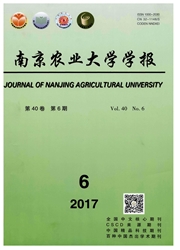

 中文摘要:
中文摘要:
在低温和短日照(18℃,L/D=8h/16h)条件下用离体叶片单头连续多代次诱导滞留型和迁飞型棉蚜的性蚜,以明确滞留型棉蚜产生有性世代的能力及其存在的生态意义。结果表明:滞留型棉蚜在诱导条件下不易产生有翅蚜,并且其繁殖模式向有性世代转变时要比迁飞型棉蚜迟1个世代。滞留型和迁飞型棉蚜均具有产生雌性蚜和雄性蚜的能力,并且存在多种繁殖模式。滞留型和迁飞型棉蚜中能产生性母蚜的个体,也可同时产生孤雌后代,雄性母不仅可以产生雄性蚜,而且可以产生孤雌蚜,并且在滞留型棉蚜中还发现了雄性母产生雄性母后代的现象。夏季滞留于越冬寄主木槿上的棉蚜完全具备营同寄主生活史的条件,它的存在有其生态与进化意义。
 英文摘要:
英文摘要:
In order to illustrate the capacity of sedentary aphids to produce sexual generation and the ecological value of the existence of this kind of aphids on an overwintering host in summer,the inducements of sexual forms in the sedentary and migratory population of cotton aphid,Aphis gossypii Glover,were conducted under low temperature and short photoperiod conditions ( 18 ℃,L/D =8 h/16 h) using the cotton leaf method to culture aphids. The results showed that the migratory aphids were liable to produce winged forms and transferred their reproductive mode from parthenogenesis to sexual reproduction one generation earlier than that of the sedentary aphids. Both of the sedentary and migratory aphids produced sexual females and males,and there were several reproductive modes. The aphids which produced sexuparae could produce virginoparae,and the male sexuparae produced the male and virginoparae. The fact that the male sexuparae produced the male sexuparae offspring had been also found in the sedentary population. The sedentary aphids on the overwintering host plant in summer entirely had the capacity to undergo the autoecious life history,and their existence would play an important role in ecology and evolution.
 同期刊论文项目
同期刊论文项目
 同项目期刊论文
同项目期刊论文
 期刊信息
期刊信息
